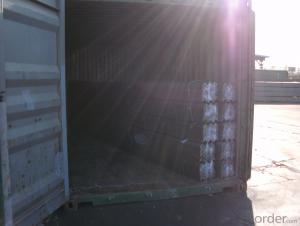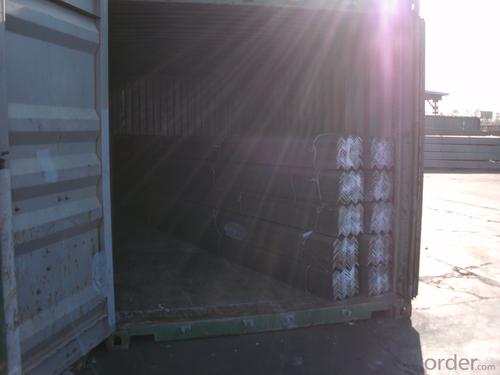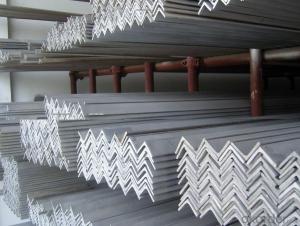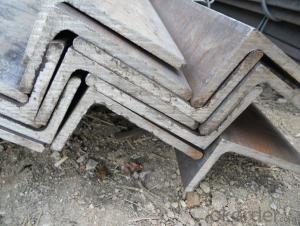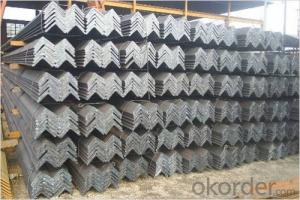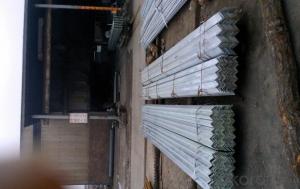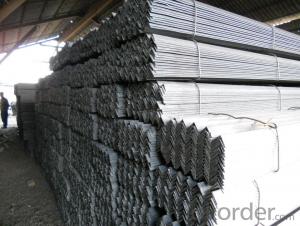Hot Rolled Steel Equal Angle Bar Q235
- Loading Port:
- China Main Port
- Payment Terms:
- TT or LC
- Min Order Qty:
- -
- Supply Capability:
- -
OKorder Service Pledge
OKorder Financial Service
You Might Also Like
Product Description:
OKorder is offering Angle Bar at great prices with worldwide shipping. Our supplier is a world-class manufacturer of steel, with our products utilized the world over. OKorder annually supplies products to European, North American and Asian markets. We provide quotations within 24 hours of receiving an inquiry and guarantee competitive prices.
Product Applications:
According to the needs of different structures, Angle can compose to different force support component, and also can be the connections between components. It is widely used in various building structures and engineering structures such as roof beams, bridges, transmission towers, hoisting machinery and transport machinery, ships, industrial furnaces, reaction tower, container frame and warehouse etc.
.
Product Advantages:
OKorder's Angle Bar are durable, strong, and resist corrosion.
Main Product Features:
· Premium quality
· Prompt delivery & seaworthy packing (30 days after receiving deposit)
· Corrosion resistance
· Can be recycled and reused
· Mill test certification
· Professional Service
· Competitive pricing
Product Specifications:
1. Invoicing on theoretical weight or actual weight as customer request
2. Length: 6m, 9m, 12m as following table
3. Sizes
:
Packaging & Delivery of Angle Steel
1. Packing: it is nude packed in bundles by steel wire rod
2. Bundle weight: not more than 3.5MT for bulk vessel; less than 3 MT for container load
3. Marks:
Color marking: There will be color marking on both end of the bundle for the cargo delivered by bulk vessel. That makes it easily to distinguish at the destination port.
Tag mark: there will be tag mark tied up on the bundles. The information usually including supplier logo and name, product name, made in China, shipping marks and other information request by the customer.
If loading by container the marking is not needed, but we will prepare it as customer request.
FAQ:
Q1: Why buy Materials & Equipment from OKorder.com?
A1: All products offered byOKorder.com are carefully selected from China's most reliable manufacturing enterprises. Through its ISO certifications, OKorder.com adheres to the highest standards and a commitment to supply chain safety and customer satisfaction.
Q2: How do we guarantee the quality of our products?
A2: We have established an advanced quality management system which conducts strict quality tests at every step, from raw materials to the final product. At the same time, we provide extensive follow-up service assurances as required.
Q3: How soon can we receive the product after purchase?
A3: Within three days of placing an order, we will begin production. The specific shipping date is dependent upon international and government factors, but is typically 7 to 10 workdays.
Images:
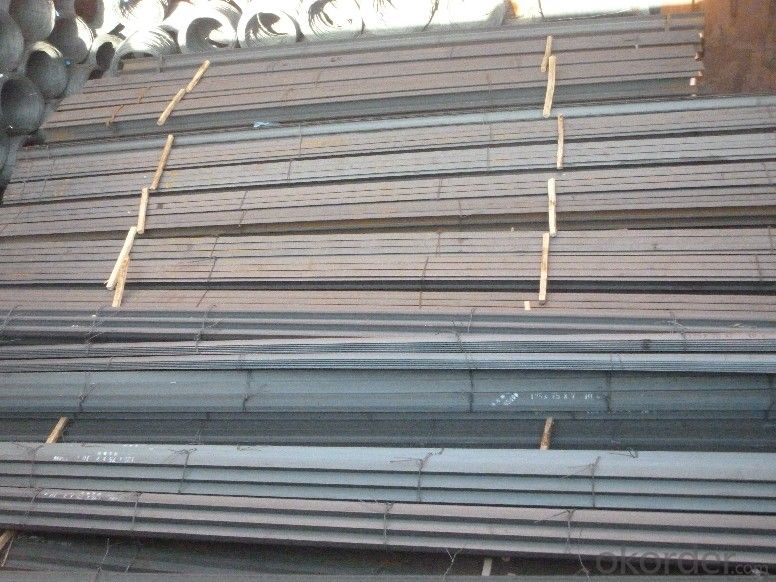
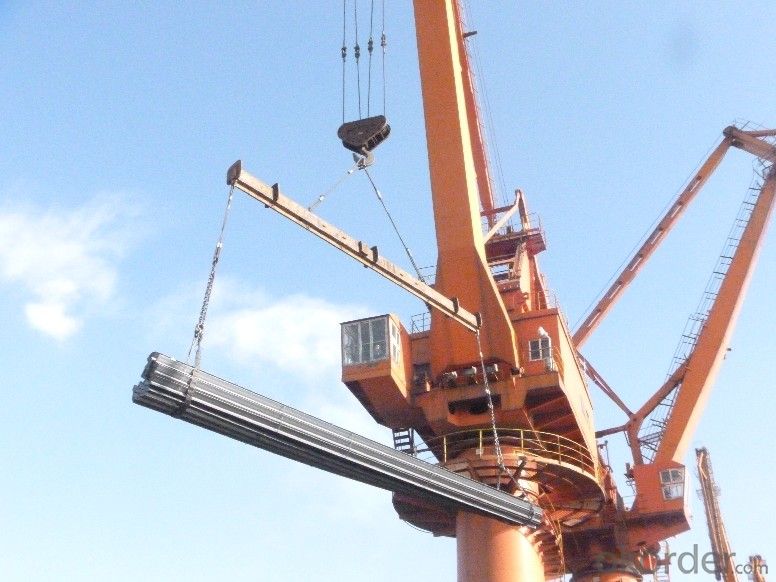
- Q: What are the welding techniques used for steel angles?
- There are several welding techniques that can be used for steel angles, depending on the specific application and desired outcome. Some of the commonly used welding techniques are: 1. Shielded Metal Arc Welding (SMAW): Also known as stick welding, SMAW involves the use of a consumable electrode coated in flux. This technique is versatile, cost-effective, and suitable for various thicknesses of steel angles. 2. Gas Metal Arc Welding (GMAW): Also known as MIG (Metal Inert Gas) welding, GMAW uses a wire electrode fed through a welding gun. The wire is melted and joined with the base metal, while an inert gas shield protects the weld from atmospheric contamination. GMAW is commonly used for thin to medium thickness steel angles. 3. Flux-Cored Arc Welding (FCAW): Similar to GMAW, FCAW uses a continuous wire electrode. However, the wire is filled with flux, eliminating the need for an external shielding gas. FCAW is suitable for both indoor and outdoor applications and is known for its high deposition rates. 4. Gas Tungsten Arc Welding (GTAW): Also known as TIG (Tungsten Inert Gas) welding, GTAW utilizes a non-consumable tungsten electrode and a separate filler metal if needed. This technique produces high-quality, precise welds and is commonly used for thinner steel angles or when a high degree of control is required. 5. Submerged Arc Welding (SAW): SAW involves the use of a continuously fed wire electrode submerged in a granular flux. The flux acts as a protective layer, preventing atmospheric contamination and enhancing weld quality. SAW is commonly used for thicker steel angles or in situations where high deposition rates are required. It is important to consider factors such as the thickness of the steel angles, the environment in which the welding will take place, and the desired quality and strength of the weld when selecting the appropriate welding technique. Consulting with a professional welder or engineer can help determine the best technique for a specific application.
- Q: How are steel angles priced?
- Steel angles are priced based on various factors including the quality and grade of the steel, the supply and demand in the market, the size and dimensions of the angle, and any additional processing or finishing required.
- Q: How do you transport steel angles safely?
- Transporting steel angles safely requires proper planning and adherence to specific guidelines. Here are a few steps to ensure the safe transportation of steel angles: 1. Secure the steel angles: Start by ensuring that the steel angles are properly secured before transportation. This can be done by using straps or chains to hold them in place. Make sure the angles are tightly secured to prevent any movement or shifting during transit. 2. Use suitable transportation equipment: Select the appropriate transportation equipment based on the quantity and size of the steel angles. Flatbed trucks or trailers with secure tie-down points are often used to transport steel angles. If necessary, consider using specialized equipment such as cranes or forklifts to load and unload the angles safely. 3. Protect the steel angles: To prevent damage during transit, it's crucial to protect the steel angles from potential hazards. This can be achieved by using suitable packaging materials such as cardboard or wooden crates to cover the angles and provide additional support. Additionally, consider using protective padding or blankets to prevent scratches or dents. 4. Ensure weight distribution: Proper weight distribution is essential to maintain stability during transportation. Make sure the load is evenly distributed across the transportation equipment to prevent imbalance or tipping. If necessary, consult weight distribution guidelines or seek professional advice to ensure safe transportation. 5. Follow local regulations: Familiarize yourself with local transportation regulations and guidelines. Ensure compliance with any specific requirements related to securing the load, maximum weight limits, or permits required for oversized shipments. This will help ensure legal compliance and safe transportation. 6. Inspect and maintain the transportation equipment: Regularly inspect the transportation equipment for any signs of wear and tear. Check the condition of straps, chains, or tie-down points to ensure they are in good working order. Properly maintained equipment reduces the risk of accidents or incidents during transportation. 7. Plan the route and consider weather conditions: Before transporting steel angles, plan the route carefully, taking into account any potential obstacles or road conditions that may impact safety. Be aware of any height or weight restrictions on certain roads or bridges. Additionally, consider weather conditions such as heavy rain, snow, or high winds, and adjust the transportation plan accordingly. By following these steps and taking necessary precautions, you can transport steel angles safely, minimizing the risk of damage, accidents, or injuries. Always prioritize safety and ensure compliance with applicable regulations for a successful transportation process.
- Q: Are steel angles available in different lengths?
- Yes, steel angles are available in different lengths.
- Q: Can steel angles be used in marine environments?
- Yes, steel angles can be used in marine environments. Steel angles are commonly used in the construction industry due to their strength and versatility. In marine environments, where corrosion and exposure to saltwater can be a concern, it is important to use corrosion-resistant materials. Stainless steel angles or galvanized steel angles are often used in marine applications as they offer excellent resistance to corrosion. These materials have protective coatings or alloys that prevent rusting and degradation, ensuring their durability and longevity in marine environments. Additionally, steel angles can be designed and fabricated to meet specific requirements and regulations for marine structures such as shipbuilding, offshore platforms, and marine piers.
- Q: Can steel angles be used for decorative trims?
- Yes, steel angles can be used for decorative trims. Steel angles can be shaped and cut to create various decorative designs and patterns, making them a versatile option for adding aesthetic appeal to architectural or interior projects. Additionally, steel angles offer durability and strength, ensuring that the decorative trims will be long-lasting and able to withstand wear and tear.
- Q: What are the common surface treatments for steel angles?
- There are several common surface treatments for steel angles, depending on the desired application and level of corrosion resistance required. Some of the most common surface treatments include: 1. Hot-dip galvanizing: This process involves immersing the steel angles in a bath of molten zinc, which forms a protective layer on the surface. Hot-dip galvanizing provides excellent corrosion resistance and is commonly used in outdoor applications. 2. Powder coating: Powder coating involves applying a dry powder to the surface of the steel angles, which is then cured under heat to form a protective and decorative coating. Powder coating is highly durable and provides good corrosion resistance, making it suitable for both indoor and outdoor applications. 3. Paint: Painting steel angles is a cost-effective and versatile surface treatment option. The steel angles are typically primed with a rust-inhibiting primer and then painted with a suitable topcoat. Paint provides a decorative finish and some level of corrosion resistance, although it may not be as long-lasting as other treatments. 4. Electroplating: Electroplating is a process where a thin layer of metal, such as zinc or chrome, is deposited onto the surface of the steel angles using an electric current. This treatment provides both corrosion resistance and aesthetic appeal, making it suitable for various applications. 5. Anodizing: Anodizing is typically used for aluminum, but it can also be applied to steel angles. This process involves creating an oxide layer on the surface of the metal, which provides corrosion resistance and improved durability. Anodizing can also provide a decorative finish and is commonly used in architectural applications. It's important to note that the choice of surface treatment for steel angles depends on factors such as the intended use, budget, and environmental conditions. Consulting with professionals or experts in the field can help determine the most suitable surface treatment for a specific application.
- Q: Can steel angles be used for agricultural buildings or barns?
- Indeed, agricultural buildings or barns can employ steel angles. The prevailing usage of steel angles in construction is attributed to their robustness and endurance. Specifically, they prove invaluable in agricultural buildings or barns, where the structure must endure substantial burdens and adverse weather conditions. Steel angles can be employed in the framing, bracing, and reinforcement of diverse building constituents, including walls, roofs, and doors. Furthermore, steel angles can be readily fabricated and tailored to fulfill precise design specifications, rendering them a multifaceted option for agricultural buildings or barns.
- Q: Can steel angles be used as reinforcements in masonry walls?
- Yes, steel angles can be used as reinforcements in masonry walls. Steel angles are commonly used in construction to provide additional strength and support to various structures, including masonry walls. They can be strategically placed within the wall to help distribute the load and prevent cracking or structural failure. Steel angles are typically made from galvanized or stainless steel, which makes them resistant to corrosion. This makes them a suitable choice for reinforcing masonry walls, as they can withstand the elements and provide long-lasting support. Additionally, steel angles can be easily customized to fit the specific requirements of the wall, allowing for flexibility in design and reinforcement. Overall, steel angles are a reliable and effective option for reinforcing masonry walls.
- Q: What is the minimum length of a steel angle?
- The minimum length of a steel angle can vary depending on the specific requirements and applications. Steel angles are typically available in standard lengths ranging from 20 feet to 40 feet. However, it is possible to cut steel angles to shorter lengths if needed. The minimum length of a steel angle would ultimately depend on factors such as the project specifications, structural requirements, and the supplier's capabilities. It is recommended to consult with a steel supplier or a structural engineer to determine the minimum length needed for a specific application.
Send your message to us
Hot Rolled Steel Equal Angle Bar Q235
- Loading Port:
- China Main Port
- Payment Terms:
- TT or LC
- Min Order Qty:
- -
- Supply Capability:
- -
OKorder Service Pledge
OKorder Financial Service
Similar products
Hot products
Hot Searches
Related keywords
